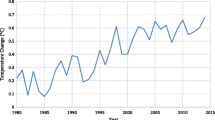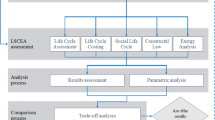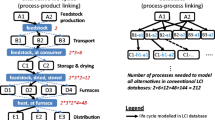Abstract
Purpose
The purpose of this paper is to take steps towards a life cycle assessment that is able to account for changes over time in resource flows and environmental impacts. The majority of life cycle inventory (LCI) studies assume that computation parameters are constants or fixed functions of time. This assumption limits the opportunities to account for temporal effects because it precludes consideration of the dynamics of the product system.
Methods
System dynamics methods are used in a consequential, fleet-based LCI that accounts for some aspects of the dynamics of the wider system. The LCI model compares the life-cycle energy consumption of car body-in-whites (BIWs) in Australia made from steel and aluminium. It incorporates two dynamic processes: the flow of BIWs into and out of the fleet, and the recycling of aluminium from end-of-life BIWs back into new BIW production. The dynamical model computes both product-based and fleet-based estimates.
Results and discussion
The product-based computations suggest that an aluminium BIW consumes less energy than a steel BIW over a single life cycle. The fleet-based computations suggest that the energy benefits of aluminium BIWs do not begin to emerge for some time. The substitution of aluminium for steel is a low-leverage intervention that changes the values of a few parameters of the system. The system has a delayed, damped response to this intervention because the large stock of BIWs is a source of high inertia, and the long useful life leads to a slow decay of steel BIWs out of the fleet. The recycling of aluminium back into BIW production is a moderate-leverage intervention that initially strengthens a reinforcing feedback loop, driving a rapid accumulation of energy benefits. Dominance then shifts to a balancing loop, slowing the accumulation of energy benefits. Both interventions result in a measureable reduction in life-cycle energy consumption, but only temporarily divert the underlying growth trend.
Conclusions
The results suggest that product-based LCIs overestimate the short-term energy benefits of aluminium by not accounting for the time required for the stock of preexisting steel components to decay out of the fleet, and underestimate the long-term energy benefits of aluminium components by not accounting for changes in the availability of recycled aluminium. The results also suggest that interventions such as lightweighting and other efficiency measures alone can slow the growth of energy consumption, but are probably inadequate to achieve sustainable energy consumption levels if the fleet is large.



Similar content being viewed by others
References
Ashford AC (2001) Unexpected behaviors in higher-order positive feedback loops. MIT, USA. http://sysdyn.clexchange.org/sdep/Roadmaps/RM7/D-4455-2.pdf. Accessed 24 Sept 2009
Australian Automotive Intelligence (2010) Australian Automotive Intelligence Yearbook 2010, 9th edn. Australian Automotive Intelligence, Melbourne
Australian Bureau of Statistics (2008) 3222.0–Population projections, Australia, 2006 to 2101. Commonwealth of Australia, Canberra
Australian Bureau of Statistics (2011) 9390.0–Motor vehicle census. Commonwealth of Australia, Canberra
Bertram M, Buxmann K, Furrer P (2009) Analysis of greenhouse gas emissions related to aluminium transport applications. Int J Life Cycle Assess 14(Suppl 1):S62–S69
Buxman K (1994) Ecological aspects of the use of aluminium in cars, with particular regard to recycling techniques. Resour Conserv Recycl 10(1–2):17–23
Cáceres CH (2009) Transient environmental effects of light alloy substitutions in transport vehicles. Mater Des 30(8):2813–2822
Carle D, Blount G (1999) The suitability of aluminium as an alternative material for car bodies. Mater Des 20(5):267–272
Carlsson BT (2009) Selecting material for the exterior panel of a private car back door by adopting a total cost accounting approach. Mater Des 30(3):826–832
Das S (2000) The life-cycle impacts of aluminum body-in-white automotive material. J Miner Met Mater Soc 52(8):41–44
Das S (2005) Life cycle energy impacts of automotive liftgate inner. Resour Conserv Recycl 43(4):375–390
Davies G (2003) Materials for automobile bodies. Butterworth-Heinemann, Oxford, pp 224–228
Dubreuil A, Bushi L, Das S, Tharumarajah A, **anzheng G (2010) A comparative life cycle assessment of magnesium front end autoparts. SAE 2010 World Congress & Exhibition, April 2010, Detroit, MI, USA, Session: Sustainable Manufacturing, Materials and Components
Ekvall T, Assefa G, Björklund A, Eriksson O, Finnveden G (2007) What life-cycle assessment does and does not do in assessments of waste management. Waste Manag 27(8):989–996
Field F, Kirchain R, Clark J (2000) Life cycle assessment and temporal distributions of emissions: develo** a fleet-based analysis. J Ind Ecol 4(2):71–91
Forrester JW (1995) Counterintuitive behavior of social systems. Technol Rev 73(3):52–68
Hakamada M, Furuta T, Chino Y, Chen Y, Kusuda H, Mabuchi M (2007) Life cycle inventory study on magnesium alloy substitution in vehicles. Energy 32(8):1352–1360
Kelkar A, Roth R, Clark J (2001) Automobile bodies: can aluminum be an economical alternative to steel? J Miner, Met Mater Soc 53(8):28–32
Kenworthy J, Murray-Leach R, Townsend C (2005) Sustainable urban transport. In: Hargroves K, Smith M (eds) The natural advantage of nations: business opportunities, innovation and governance in the 21st century. Earthscan, London
Klöpffer W (2008) Life cycle sustainability assessment of products. Int J of Life Cycle Assess 13(2):89–95
Lovins AB, Cramer DR (2004) Hypercars, hydrogen, and the automotive transition. Int J Veh Des 35(1/2):50–85
Meadows DH (2009) Thinking in systems: a primer. Earthscan, London
Puri P, Compston P, Pantano V (2009) Life cycle assessment of Australian automotive door skins. Int J Life Cycle Assess 14(5):420–428
Ribeiro I, Peças P, Silva A, Henriques E (2008) Life cycle engineering methodology applied to material selection, a fender case study. J Clean Prod 16(17):1887–1899
Sandén BA, Karlström M (2007) Positive and negative feedback in consequential life-cycle assessment. J Clean Prod 15(15):1469–1481
Standards Australia and Standards New Zealand (1998) Australian/New Zealand Standard: Environmental management–Life cycle assessment–Principles and framework, AS/NZS ISO 14040:1998. Standards Australia, Sydney, and Standards New Zealand, Wellington
Sterman JD (2000) Business dynamics: systems thinking and modeling for a complex world. McGraw-Hill, Boston
Tharumarajah A, KoltunI P (2007) Is there an environmental advantage of using magnesium components for light-weighting cars? J Clean Prod 15(11–12):1007–1013
Udo de Haes HA, Heijungs R, Suh S, Huppes G (2004) Three strategies to overcome the limitations of life-cycle assessment. J Ind Ecol 8(3):19–32
Ungureanu CA, Das S, Jawahir IS (2007) Life-cycle cost analysis: aluminum versus steel in passenger cars. In: Das SK, Yin W (eds) Aluminium alloys for transportation packaging aerospace and other applications. TMS, USA
Acknowledgements
The authors would like to thank the Australian National University and the Commonwealth of Australia, through the Cooperative Research Centre for Advanced Automotive Technology, for their support.
Author information
Authors and Affiliations
Corresponding author
Additional information
Responsible editor: Hans-Jörg Althaus
An erratum to this article can be found at http://dx.doi.org/10.1007/s11367-011-0361-z.
Rights and permissions
About this article
Cite this article
Stasinopoulos, P., Compston, P., Newell, B. et al. A system dynamics approach in LCA to account for temporal effects—a consequential energy LCI of car body-in-whites. Int J Life Cycle Assess 17, 199–207 (2012). https://doi.org/10.1007/s11367-011-0344-0
Received:
Accepted:
Published:
Issue Date:
DOI: https://doi.org/10.1007/s11367-011-0344-0




